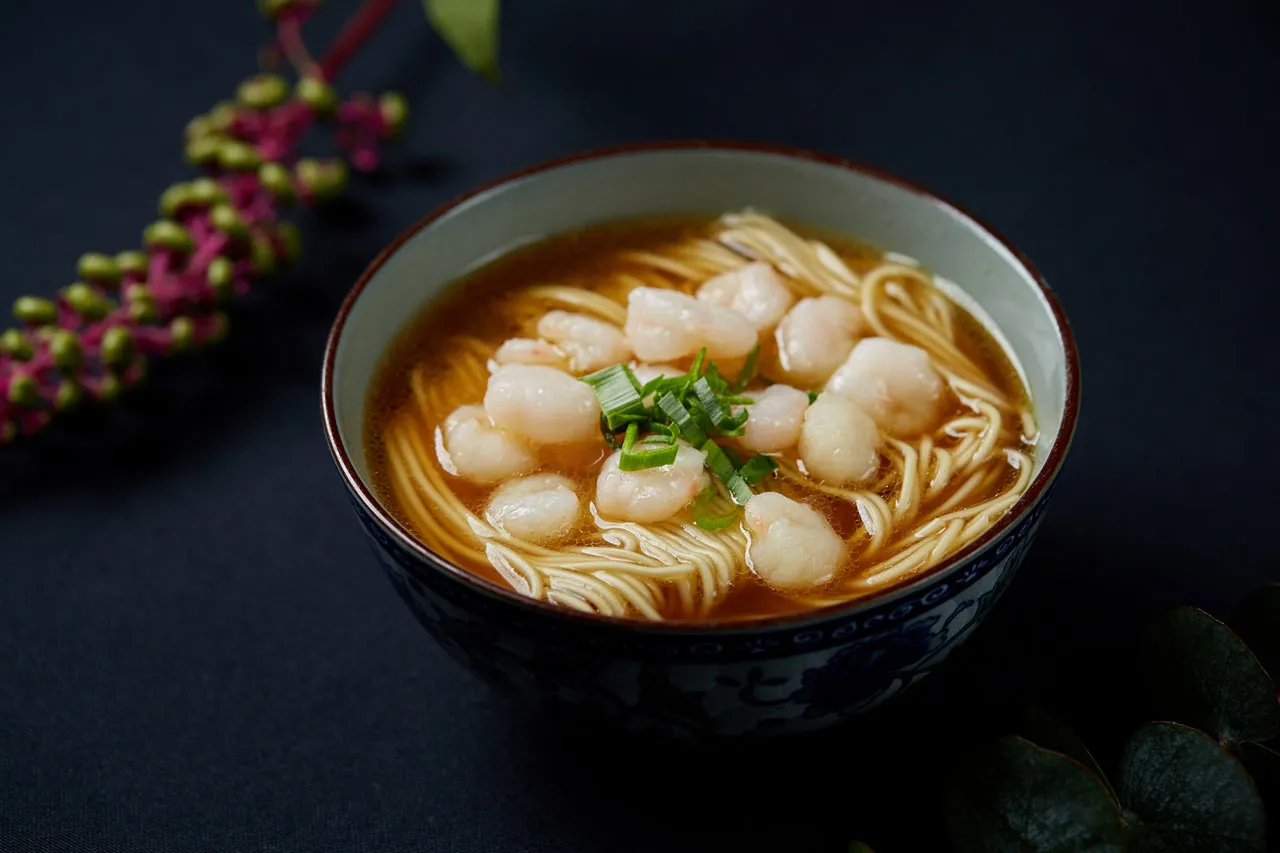A Taste of China — and the World — in Shanghai
Shanghai is a true food lover’s paradise. As one of China’s most dynamic and cosmopolitan cities, it brings together a dazzling mix of global cuisines and regional Chinese flavors. Whether you're craving classic Shanghainese dishes, fiery Sichuan fare, Cantonese dim sum, or international favorites like Mediteranean, Japanese, or Middle Eastern, you’ll find it all here. The Michelin guide started rating Shanghai restaurants in 2017 and now the city has more than 50 eateries holding Michelin stars, with many more recommended by the guide.
As a cultural crossroads, Shanghai blends influences from across China and around the world — and nowhere is that more evident than at the dining table. China itself is a vast and diverse land, home to 56 ethnic groups and an incredible variety of landscapes, from snow-capped peaks and fertile river valleys to deserts and tropical rainforests. Naturally, this diversity is reflected in its food.
To help navigate this rich culinary landscape, Chinese cuisine is traditionally divided into the "Four Great Traditions," each rooted in a different region of the country. We’ll introduce you to some of the most popular ones — and show you the very best places to sample this diverse range of cuisines across the city.
Exploring Northern Flavors
Northern Chinese cuisine is hearty, bold, and deeply satisfying. In regions like Shandong 山东 and Dongbei 东北(Northeast China), the focus is on wheat-based staples like noodles, dumplings, and steamed buns rather than rice. The cooking style leans heavily on techniques like braising, roasting, and stewing, and seafood features prominently, especially in Shandong dishes.
Dongbei cuisine, in particular, is known for its comforting flavors and generous portions. In Shanghai, it’s easy to find great examples of these northern specialties, from rich stews and hearty dumplings, to hand-pulled noodles.
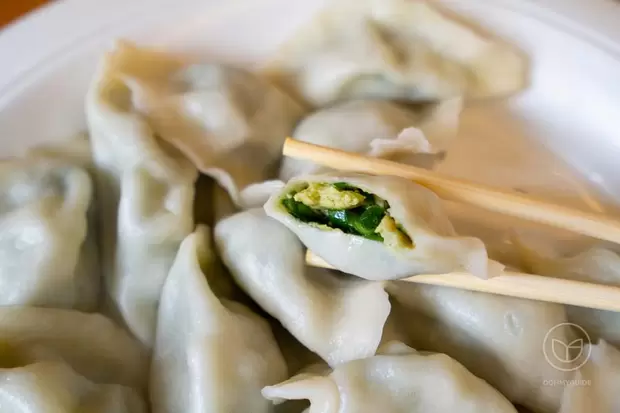
Dongbei Dumplings
No exploration of northern cuisine would be complete without mentioning the imperial flavors of Beijing. Peking dishes — especially the iconic Peking roast duck — are legendary in Chinese culinary history. Other northern classics include mutton hot pot, a winter favorite, and Dongbei-style dumplings, prized for their thick skins, juicy fillings, and traditional pairings like vinegar and raw garlic — plus a range of hearty wheat-based snacks that have stood the test of time.
Our Picks
Dongbei Cuisine (东北菜):
- Master Yu’s Harbin Home (冰城老于家) - A well-loved spot for authentic Northeastern comfort food.
- Four Seasons Dumpling King (四季饺子王) – Famous for handmade dumplings and other Dongbei specialties.
Peking Cuisine (京菜):
- Xindalu (新大陆) – Located in the stylish Hyatt on the Bund, this upscale venue is known for its excellent Peking duck.
- Da Dong (大董) – A famous Beijing-based chain with multiple branches in Shanghai; both the iapm and Park Place locations have earned Michelin stars.
- Wan Su Cui (万酥脆) – A busy, fast-growing roast duck chain offering affordable Peking duck with crispy skin and tender meat.
Dim Sum and More: Southern China’s Culinary Delights
When it comes to southern Chinese cooking, Cantonese cuisine (Guangdong Cai 广东菜) stands out as one of the most refined and internationally celebrated styles. Known for its focus on fresh ingredients, precise cooking methods, and elegant presentation, it’s often considered the gold standard of Chinese gastronomy.
Thanks to Guangdong’s subtropical climate and long growing season, the region is home to an incredible variety of ingredients. The Cantonese culinary philosophy is simple: let quality ingredients shine with minimal seasoning. Delicate stir-fries with just garlic and ginger, gently steamed fish or meats, and light, balanced sauces are hallmarks of the cuisine. Unlike the north, where wheat-based staples dominate, here it’s all about rice.
Of course, no mention of Cantonese food would be complete without dim sum — those beloved small plates served in steaming baskets or on tiny dishes. From shrimp dumplings to rice noodle rolls, dim sum is a weekend ritual for many families in southern China — and it’s become a global dining phenomenon.
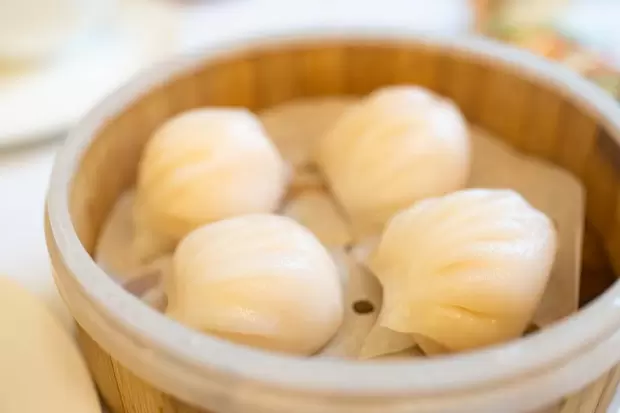
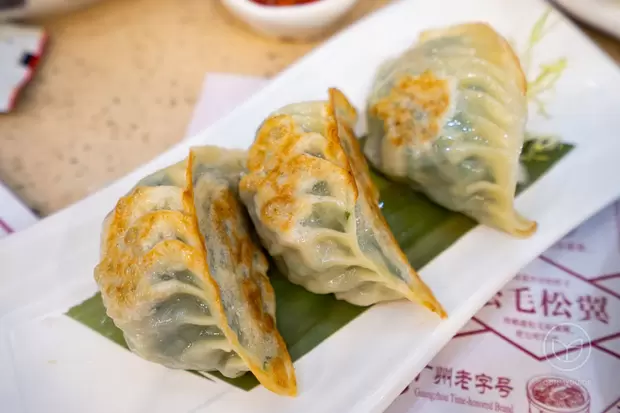
Canton dim sum
Shanghai has an abundance of riches in this area, with many Guangdong chains setting up store in recent years. For those seeking a luxurious dining experience, Shanghai boasts several world-class Cantonese restaurants where tradition meets impeccable craftsmanship in stunning settings.
Our Picks
Dim Sum & Cantonese Favorites:
- Tang Palace (唐宫) – A polished chain known for consistently high-quality Cantonese dishes, including expertly roasted pigeon and an extensive dim sum menu.
- Dian Du De (点都德) – A long-standing favorite from Guangzhou with branches in Shanghai. Great for traditional dim sum in a lively setting, at very reasonable prices.
High-End Cantonese Dining:
- Bao Li Xuan (宝丽轩) – Located in the ultra-luxurious Bvlgari Hotel, this two-Michelin-starred restaurant delivers an elevated Cantonese experience with refined technique, premium ingredients, and exceptional service in an historic setting.
- T’ang Court (唐阁) – Housed in The Langham, this Michelin-starred restaurant is renowned for its exquisite interpretations of Cantonese classics, including signature dim sum and delicately prepared seafood.
Bold and Spicy: The Rich Flavors of Southwest China
To the west, Chinese cuisine turns bold, complex, and famously spicy with Sichuan cuisine. While chili peppers are essential in dishes like gongbao jiding 宫保鸡丁 (kung pao chicken) and mapo tofu 麻婆豆腐, the defining ingredient is actually huajiao 花椒 — Sichuan peppercorn. This unique spice creates a signature tongue-numbing sensation known as ma la 麻辣 (“numbing spice”), perfectly balancing the heat from the chilies.
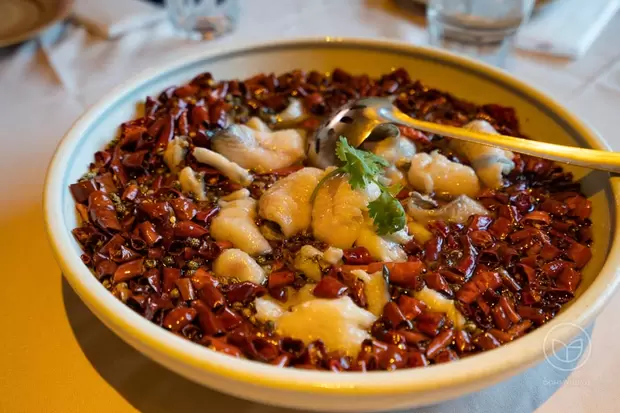
Sichuan Poached Fish in Chili Oil
One of Sichuan’s most beloved culinary traditions is Sichuan hotpot — a bubbling, flavorful broth filled with meats, vegetables, and noodles, cooked right at the table. The broth itself often combines both spicy (with lots of chili and peppercorn) and mild sections, making it perfect for sharing and customizing your heat level.
Moving south, Hunan cuisine doubles down on fiery heat with a style called gan la 干辣 (“dry spicy”), using generous amounts of fresh red chilies and smoked meats. Signature dishes include cumin pork ribs (孜然排骨), steamed fish head with red and green chilies (双椒鱼头), and ground pork with pickled long beans (酸豆角肉末).
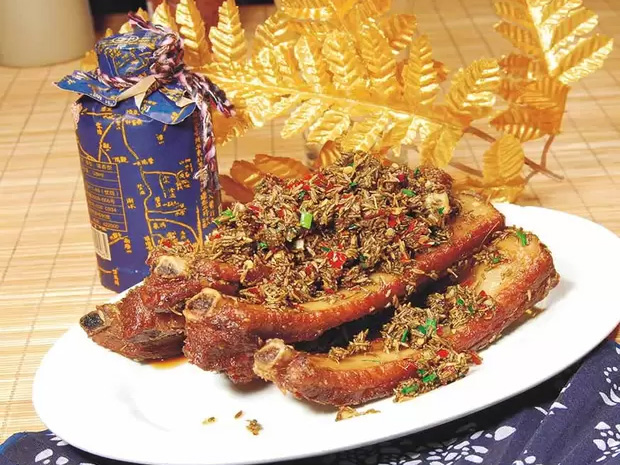
Cumin pork ribs 孜然排骨
Further south in Yunnan Province, a melting pot of 25 ethnic groups and diverse landscapes, culinary traditions vary widely. Here, fresh flowers, herbs, and wild mushrooms are common ingredients, creating vibrant, fresh, and often herbal flavors.
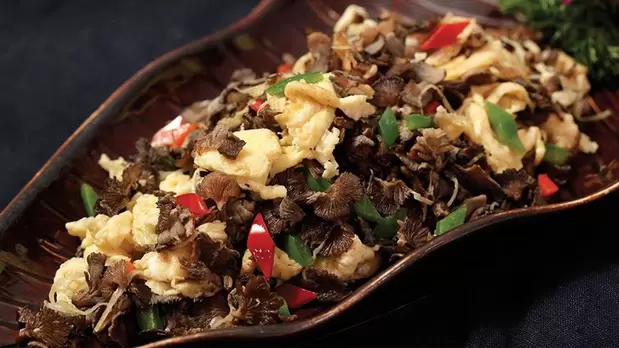
Yunnan scrambled eggs with white mushroom
Finally, far to the northwest is Xinjiang, home to China’s Uyghur people, where cuisine is a crossroads of Chinese and Central Asian influences. Expect cumin-scented mutton kebabs (羊肉串), roasted lamb dumplings (烤包子), fragrant rice pilaf, and da pan ji (大盘鸡) — a hearty stew of chicken, vegetables, and potatoes.
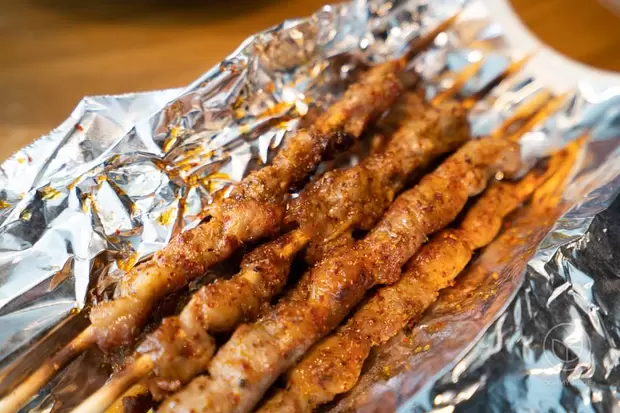
Xinjiang Grilled Lamb Skewers
Our Picks
Sichuan Cuisine & Hotpot:
- Sichuan Citizen (龙门阵茶屋) – A great introduction to Sichuan food, with helpful staff who will happily guide you through the menu.
- Kong Que Chuan Cai (孔雀川菜) – Traditional Sichuan dishes in a warm, inviting setting.
- Hong Jie Hotpot (鸿姐老火锅) – A busy hotpot spot serving bold, authentic Chongqingstyle mala broth with crisp fresh ingredients.
Hunan Cuisine:
- Di Shui Dong (滴水洞) – A longstanding Shanghai favorite, authentic Hunan dishes in a lively setting.
- Liu Yue Ban Hunan Xiang Xian Guan (六月半湖南湘鲜馆) – A go-to for big spice and bold flavors in a more refined environment.
Yunnan Cuisine:
- Lotus Eatery – Celebrated for fresh, fragrant Yunnan dishes showcasing the region’s herbal and floral ingredients.
- Lost Heaven (花马天堂) – A stylish restaurant serving vibrant Yunnan specialties in a beautiful atmosphere with a fine rooftop terrace.
Xinjiang Cuisine:
- Xibo (锡伯) – Modern Xinjiang restaurant in a chic setting using fresh ingredients sourced from Xinjiang Province.
- Yershari (耶里夏丽) – Offers a delicious blend of Central Asian and Chinese flavors with authentic Uyghur cooking.
East Coastal Elegance: Jiangsu, Zhejiang & Shanghainese Cuisine
In eastern China, Jiangsu Province, often called the “Land of Fish and Rice,” was once a cultural and economic hub, especially along the Grand Canal that linked the Yangtze and Yellow Rivers. Cities like Yangzhou thrived as centers of commerce, and a wealthy merchant class developed a refined taste for fresh, seasonal cuisine. Jiangsu dishes emphasize delicate ingredients—especially freshwater fish and crustaceans—and showcase skilled techniques like intricate knife work, red braising, quick frying, stewing, and subtle pickling.
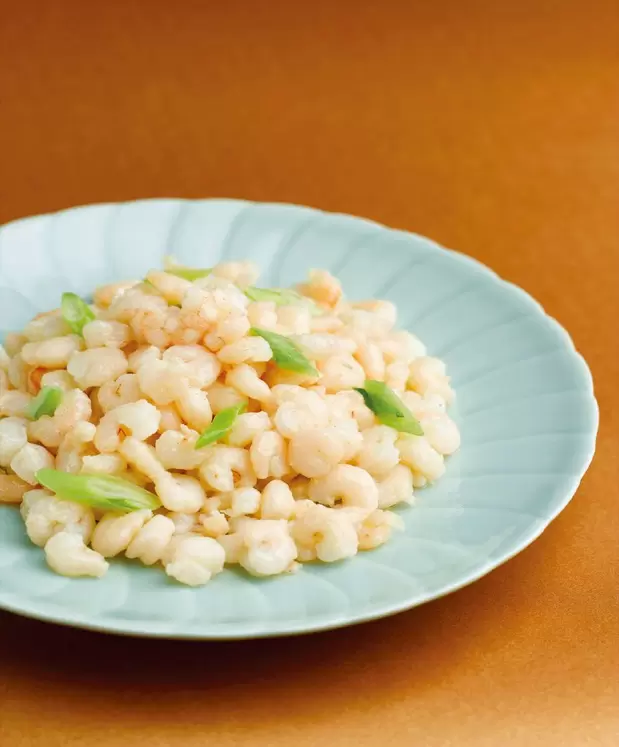
Sautéed Shelled Shrimp
Shanghai’s local cuisine may not be one of the “Four Great Traditions,” but it’s a compelling blend of flavors from neighboring Jiangsu and Zhejiang—and deeply rooted in its own traditions as a historic port city. Must-try Shanghainese specialties include steamed xiaolong bao (小笼包), delicious thin skinned soup filled dumplings, and panfried shengjian bao (生煎包), chunkier crisp skinned fried dumplings, along with the ever-popular redbraised pork (hongshao rou 红烧肉)—staples at almost every local Shanghainese restaurant. If you’re in town during October to December you’ll see the locals going mad for hairy crab, prized for its sweet meat and rich roe.
Our Picks
Jiangsu & Zhejiang Cuisine:
- Jardin de Jade (苏浙汇) – Celebrated for its elegant Jiangsu and Zhejiang dishes, served in an upscale yet welcoming setting.
- Yong Yi Ting (颐悦厅) – A one-Michelin-starred restaurant at the Mandarin Oriental offering exquisitely presented freshwater seafood and Cantonese-influenced Jiangsu specialties.
Shanghainese Favorites:
- Ren He Guan (人和馆) blends nostalgic 1930s Shanghai ambiance with high-quality, Michelin-starred Shanghainese classics—especially its famous crabmeat rice—and excellent service at surprisingly reasonable prices, though be prepared to book ahead.
- Cheng Long Hang Xie - (成隆行 蟹王府) – In town during crab season? Go here. And don’t worry if you’re unsure of how to dismantle a crab, the staff will take care of it for you.
- Jesse (吉士) – A famous local institution known for consistent quality and traditional Shanghainese fare.
- Fu 1039 (福1039) & Fu 1088 (福1088) – Upscale dining spots offering beautifully crafted Shanghainese and regional dishes in elegant settings, perfect for special occasions.
A Global Table: Western Cuisine by Renowned Chefs in Shanghai
Shanghai’s international dining landscape remains vibrant with distinguished venues led by celebrity chefs and pioneering locals alike. JeanGeorges Shanghai in Three on the Bund continues its legacy as a Michelin-starred French fusion icon, offering refined international fare with elegant Bund views. Nearby, Mercato by JeanGeorges serves up approachable Italian dishes with rustic charm and excellent value.
For those seeking innovation and sustainability, Tai’an Table (泰安门) is a must-visit. Chef Stefan Stiller’s three-Michelin-starred, Green Star–awarded restaurant presents evolving 10–12 course tasting menus that meld Western techniques and Asian ingredients—each course crafted to surprise and delight. The intimate counterstyle dining space provides a front-row seat to culinary artistry and seasonal storytelling.
Paul Pairet’s creative vision lives on at Mr & Mrs Bund, recognized for its modern FrancoChinese cuisine and stunning Bund views.
Chef Willy Trullas Moreno honed his skills in Shanghai before opening multiple outlets across Asia, his Tomatito is another standout—a creative tapas bar showcasing contemporary Spanish flavors with Spanish flair underlined by warm service and a laid-back vibe.
For something quick, casual, or familiar, Shanghai has no shortage of Western chain restaurants. McDonald’s and KFC are ubiquitous across the city, often with localized menu twists like rice bowls, egg tarts, or Sichuan-style chicken burgers. For a more local take on the Western fast-casual concept, Charlie’s Burger has built a loyal following with its juicy burgers, hand-cut fries, and house-made milkshakes, while Blue Frog (蓝蛙) offers reliable Western staples like steaks, pastas, and generous happy hour deals.
If you're craving Mediterranean flavors, Alimentari serves up Italian deli meats, fresh pastas, and imported cheeses and wines in a relaxed, neighborhood café atmosphere—with multiple locations throughout the city.
Our Picks
Fine Dining & Innovators:
- Taian Table (泰安门) – A threeMichelinstarred, sustainably focused chef’scounter concept offering ever-changing tasting menus in a minimalist, intimate setting.
- JeanGeorges Shanghai – Globally renowned French cuisine with upscale ambiance and riverside charm at Three on the Bund.
- Mercato – JeanGeorges’s rustic Italian concept offering woodfired dishes in a stylish, open setting.
- Mr & Mrs Bund – Paul Pairet’s modern French bistro with creative takes on global comfort food and Bund skyline views.
- Villa le Bec – Chef Nicolas le Bec’s refined French venue in a leafy French Concession villa, combining classic European flavors with impeccable hospitality.
Bistros and Neighborhood Favorites:
- Tomatito (托玛蒂托) – Lively Spanish tapas and cocktails from chef Willy Trullas Moreno, it has a lovely outdoor terrace.
- Cellar to Table – A chef-driven wine bistro housed in an old villa, focused on seasonal small plates and natural wines.
- Alimentari – A casual neighborhood Italian deli and wine bar offering deli meats, pastas, and imported cheeses across several stylish city locations.
Casual & Family-Friendly Chains:
- Charlie’s Burger – A Shanghai-born burger chain known for its juicy patties, thick shakes, craft beers and casual vibe.
- Blue Frog (蓝蛙) – A long-standing local favorite for Western comfort food, big burgers, and weekday happy hours.
Going Green: Vegetarian Eating in Shanghai
Eating vegetarian in Shanghai can be surprisingly rewarding—once you know how to ask. Many locals interpret "vegetarian" loosely, so it’s worth clarifying that you don’t eat meat, seafood, or animal-based broths. Thankfully, Buddhist culinary traditions run deep here, and nearly every temple has an adjoining vegetarian restaurant offering simple but tasty plant-based dishes. There are also many entirely vegetarian spots that are known for turning tofu, mushrooms, and seasonal vegetables into dishes that are flavorful, filling, and entirely meat-free.
Our Picks:
- Fu He Hui 福和慧 – A refined, Michelin-starred fine dining experience in Changning District focused entirely on creative vegetarian tasting menus.
- Wuguantang Vegetarian Restaurant (悟观堂素食馆) – Located on leafy Xinhua Road, this restaurant is known for its calm atmosphere and carefully crafted vegetarian dishes rooted in Buddhist traditions.
- Lihan (礼涵素食餐厅) – one of the oldest and best loved vegetarian destinations in Shanghai.
